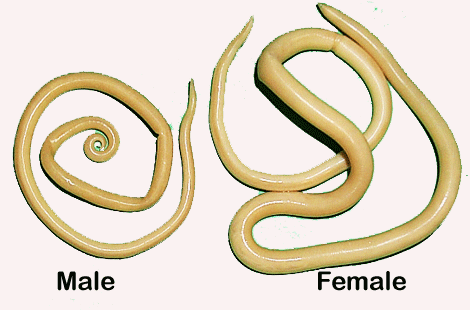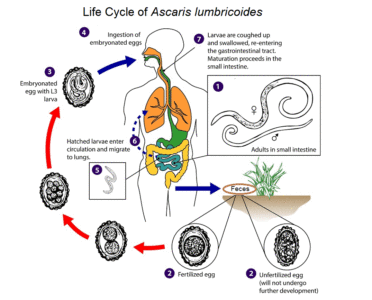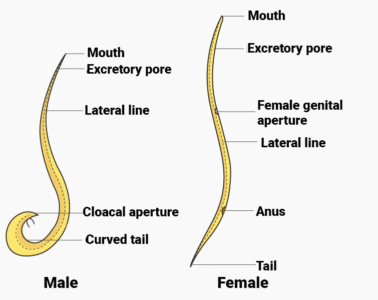The worm is known as roundworm. It is present all over the world where environmental hygiene is low. The adult worm lives in the lumen of small intestine of human. About 807 million to 1.2 billion people are infected with Ascaris lumbricoides throughout the world. Among them, 10 percent people is infected in the developing world (WHO). Infection created by Ascaris lumbricoides is known as Ascariasis.
Systematic Position
- Phylum: Nematoda
- Class: Chromadorea
- Order Ascaridida
- Family: Ascarididae
- Genus: Ascaris
- Species: Ascaris lumbricoides
Morphology
It is resemble ordinary earthworm. It is brownish or pinkish in color while in the intestine. It is round or tapered at both ends, the anterior end is thinner than posterior end. One dorsal and two ventral finely toothed lips are present. The male can grow up to 31 cm in length with 2-4 mm in diameter while the female is slightly larger than the male. The female grows up to 49 cm in length with 3-6 mm in diameter.

Life Cycle of Ascaris lumbricoides
Roundworm passes its life cycle in one host. No intermediate host is required. Humans are the definite host. The life cycle includes three stages: Adult, larva and ova.
Adult roundworms live in the lumen of the small intestine of humans. A fertilized female lays about 200,000 eggs per day. Fertilized or unfertilized eggs having unsegmented ovum are passed in the stool. Unfertilized eggs cannot become infective. Freshly passed fertilized ova are also not infective. In soil, a rhabditiform larva develops within eggs shell of a fertilized egg in 30-40 days. The egg having the rhabditiform larva is infective to man.
The larva undergoes first mounting within the egg. Human is infected by ingestion of eggs having rhabditiform larva with food, drink or raw vegetables. The rhabditiform larvae are liberated in the duodenum as the egg shell is broken by the digestive juices. The larva burrow through mucuous membrane of small intestine and are carried by the portal circulation to the liver. Then via the intrahepatic vein, inferior vena cava and right side of the heart they enter the pulmonary circulation.

In the lungs they moult twice (second and third moults). They penetrate through the capillary wall into the lung alveoli in about 7 days. 10-15 days are taken for this migration. From the lung alveoli, the larvae crawl up the bronchi, trachea and larynx to the epiglottis and pharynx and are then swallowed.
Finally, they enter in the upper part of the small intestine where they moult once more (fourt moult) and grow into adult mature worms. Adult worms become sexually mature in about 6 to 10 weeks time. The gravid females begin to lay eggs in about 2 months from the time of the infection. The cycle is complete and a fresh cycle starts. Ascaris infection mar rarely occur by inhalation of eggs.
Pathogenesis
The harm that roundworm does to infected humans is due to the presence of both the larvae and adult worms.
Larval Stage:
It is also known as blood-lung migration phase. Migrating larvae enter venules and lymph vessels of intestine. During this period, larvae grow so when they reach capillaries of the air sacs in lungs, they are too big to pass through them. They burst through the vessels and cause bleeding into the air sacs.
Pneumonia like symptoms (Loeffer`s syndrome) can occur. Through blood circulatory system, larvae may end up in several organs, including eyes, brain and spinal cord with serious consequences. Eosinophilia is generally present and there is often utricaria. Signs of toxaemia may develop and rarely neurological disorders.
Adult Stage
In the intestine, few adult worms usually produce no symptoms. A heavy worm burden can result in serious manifestations. Adult worm normally feeds on partly digested food from human intestine. Host (having about 26 worms) may loss 10% of his/her total daily intake of protein.
Roundworm infection in children may contribute to vitamin A and C deficiencies. As the parasite discharge its wastes directly into the host, poisons from heavy infections may affect the host.
Wandering adults nay cause intestinal obstruction. Migrating adults may provoke severe pathology when they wonder into other organs.
Clinical Features
In ascariasis the effect may be produced by adult worms, eggs, and migrating larvae.
Manifestation due to adult worms:
Symptoms are related to the worm burden. Asymptomatic: Adult worms may live in the intestine without producing any symptom. 10 to 12 worms may go unnoticed except demonstrated in a routine stool examination.
Effects of Adult Worms
The commonest complaint is vague abdominal pain. In more severe cases, the patient may experience the following:
- Listlessness
- Weight loss
- Anorexia
- Distended abdomen
- Nausea
- Intermittent loose stool and
- Occasional vomiting.
- Vomiting
- Irregular stools or diarrhea
- intestinal blockage, which causes severe pain and vomiting
- Loss of appetite
- Abdominal discomfort or pain
- Weight loss
- Growth impairment in children due to malabsorption
Roundworm uses nutrition/(nutrients of the host particularly in heavy infection in children and contributes to malnutrition and retarded growth. Toxic body fluid of roundworm may cause fever.
Allergic Manifestations
Utricaria, dyspnoea, features of status asthmaticus may occur. Ascais encephalopathy may occur.
Mechanical Effects
Adult worms may form tangled mass causing intestinal obstruction.
Ectopic Ascariasis (due to migration)
The adult worms frequently migrate: (1) May be vomited out or at night may come out through the mouth or nose. During these migrations the worms may enter the respiratory passages causing asphyxia, particularly in children. (2) May enter the lumen of appendix causing appendicitis. (3) May block the ampula of Vater causing obstructive jaundice and pancreatitis (4) May enter bile duct and even intrahepatic ducts causing obstructive jaundice. In the liver adult worm may produce chronic granulomatous lesions.
Effects due to Eggs
Eggs do not cause any lesion in the intestine, Ova in the biliary canaliculi and liver may produce inflammatory changes.
Manifestations due to Migrating Larvae
Roundworm in Lungs can cause:
- Loeffler`s syndrome (Ascaris pneumonia) may develop with non productive cough,
- Wheezing or shortness of breath
- Aspiration pneumonia
- Dyspnea,
- Blood-tinged sputum (which may contain larvae) and
- Substemal discomfort.
- Blood in mucus
- Chest discomfort
- Fever (up to 38.5 0C).
These symptoms begin 5 to 6 days after infection usually last 10 to 12 days and are caused by the roundworm larvae migrating and developing inside the human body. Eosinophilia (20%) may occur.
Larvae in systemic circulation, from lungs may rarely migrate and produce lesions in various organs like brain, heart, kidneys.
Complications of Ascariasis
Heavy infection can cause the following complications:
- Intestinal blockage
- Duct blockage
- Nutritional deficiency
Treatment of Ascariasis
Ascariassis usually is treated with anti-parasitic drugs. Medications most commonly used include:
- Ivermectin (Stromectol)
- Albendazole (Albenza)
- Mebendazole (Vermox)
Difference between Male and Female Roundworm
|
Characteristic Features |
Male |
Female |
|---|---|---|
|
Size: Length |
10-31 cm |
20 – 49 cm |
|
Posterior end |
It is pointed and curved ventrally. |
It is not curved. Conical and straight. |
|
Genital Pore |
At posterior end. Opens into cloaca. |
Vulva opens at the junction of anterior and middle thirds on ventral aspect. |
|
Copulatory spicules |
Two spicules. |
Absent. |
|
Anus |
Opens into cloaca. |
Opens directly on ventral surface. |

Image Showing Differences Between Male and Female Ascaris
